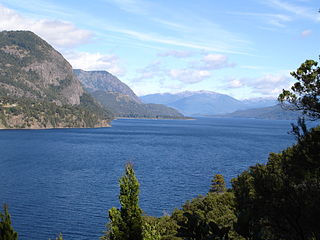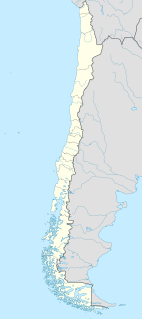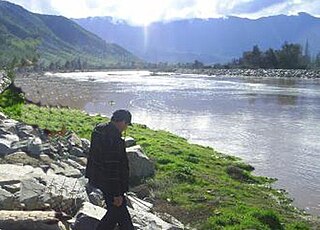Related Research Articles

The Biobío River is the second largest river in Chile. It originates from Icalma and Galletué lakes in the Andes and flows 380 km to the Gulf of Arauco on the Pacific Ocean.

Laja River is a river in Chile, along which can be found the Laja Falls. It is located in the Bío Bío Region. The source of the river is Laguna del Laja in the Andes, then flows westward through the Chilean Central Valley and terminates into the Bío Bío River, being an important tributary of it.

The Lácar Lake is a lake of glacial origin in Neuquén Province, Argentina. It is enclosed in a mountain range of the Andes, at 630 m above mean sea level, approximately at 40°11′S71°32′W. The area around the lake is mostly uninhabited, except for the small city of San Martín de los Andes on its northeastern coast.

The Diamante River is a river in the Argentine province of Mendoza. It is born from glaciers on the Maipo, a volcano in the Andes range in the Argentine–Chilean border, and flows east until emptying in the Desaguadero River. Its drainage basin covers an area of 2,750 square kilometres (1,060 sq mi) in the central region of Mendoza.
The Central Valley, Intermediate Depression, or Longitudinal Valley is the depression between the Chilean Coastal Range and the Andes Mountains. The Chilean Central Valley extends from the border with Peru to Puerto Montt in southern Chile, with a notable interruption at Norte Chico. South of Puerto Montt the valley has a continuation as a series of marine basins up to the isthmus of Ofqui. Some of Chile's most populous cities lie within the valley including Santiago, Temuco, Rancagua, Talca and Chillán.

Penco is a Chilean city and commune in Concepción Province, Bío Bío Region on the Bay of Concepción. Founded as the city of Concepción del Nuevo Extremo on February 12, 1550 by Pedro de Valdivia, it is the third oldest city in Chile, after capital Santiago founded first in 1541 and La Serena second in 1544.
La Frontera is the name given to a geographical region in Chile. La Frontera can denote either the area just around Bío Bío River or the whole area between the Bío Bío and Toltén River being in this later definition largely coterminous with the historical usage of Araucanía.

Los Flamencos National Reserve is a nature reserve located in the commune of San Pedro de Atacama, Antofagasta Region of northern Chile. The reserve covers a total area of 740 square kilometres or 73,986 hectares in the Central Andean dry puna ecoregion and consists of seven separate sections.

The Chol Chol River is a river in Chile. It is situated in the Araucania Region of Chile in the village of Cholchol, just outside Temuco and with the Cautín River are tributaries of the Imperial River (Chile).

The Colorado River is a river of Chile.
The Estero Alhué is a river of Chile.
The Estero Carén is a river of Chile.
The Estero Chacabuco is a river of Chile.
The Estero La Cadena is a river of Chile.

The Estero Lampa is a river of Chile.
The Estero Pocuro is a river of Chile.
The Estero Punitaqui is a river of Chile.

The Estero Yerba Loca is a river of Chile.
The Estero Zamorano is a river of Chile.
References
- EVALUACION DE LOS RECURSOS HIDRICOS SUPERFICIALES EN LA CUENCA DEL RIO BIO BIO [ permanent dead link ]
Coordinates: 34°12′S70°32′W / 34.200°S 70.533°W

A geographic coordinate system is a coordinate system that enables every location on Earth to be specified by a set of numbers, letters or symbols. The coordinates are often chosen such that one of the numbers represents a vertical position and two or three of the numbers represent a horizontal position; alternatively, a geographic position may be expressed in a combined three-dimensional Cartesian vector. A common choice of coordinates is latitude, longitude and elevation. To specify a location on a plane requires a map projection.
| This article related to a river in Chile is a stub. You can help Wikipedia by expanding it. |
